Dedicated mum, writer, and parenting enthusiast. Sharing insights, tips, and heartwarming stories for the wonderful journey of parenthood.
About the author
Parents often wonder when it is safe for their child or baby to start sleeping with a blanket. As a Mum, I understand the importance of sleep safety for children.
According to the American Academy of Pediatrics, sleeping with blankets is unsafe for babies under 12 months old.
Introducing a blanket too early can increase the risk of accidental suffocation and Sudden Infant Death Syndrome (SIDS).
However, parents can follow guidelines to ensure their child’s sleep environment is safe and comfortable.
Some important points to consider:
- It is not safe for babies under 12 months old to sleep with blankets.
- Swaddling can be a safer alternative to blankets, but parents should stop swaddling once a baby starts rolling over.
- Layering your baby’s clothing or using a sleep sack can provide added warmth without needing a blanket.
- Wait until your baby is at least 18 months old before introducing a thin, breathable blanket made of linen, muslin, or thin cotton.
- Blankets are not necessary for a baby’s comfort or security. If introducing a comfort object, ensure it is small and not used for playing.
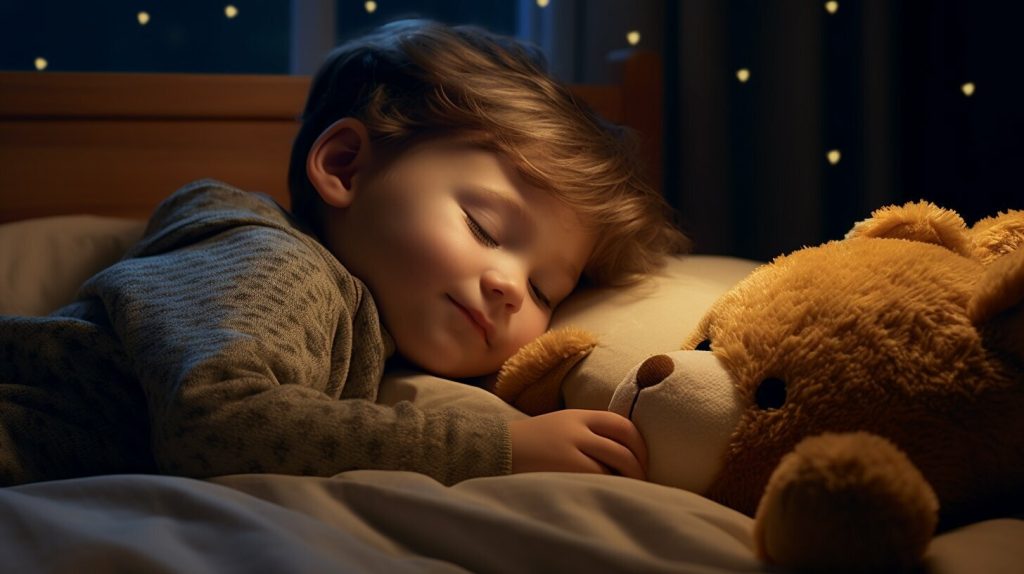
The Importance of Sleep Safety for Children And Babies
Ensuring sleep safety for children is essential for their well-being and development. As parents, we are responsible for creating a safe childs sleep environment that promotes healthy and restful sleep.
One important aspect of sleep safety is knowing when and how to introduce a blanket to a child’s sleep routine.
Instead of using blankets, parents can opt for safer alternatives such as swaddling or using sleep sacks. Swaddling can provide security and warmth, but it is important to stop swaddling once a baby starts rolling over.
When considering the appropriate age to introduce a blanket, waiting until the child is at least 18 months old is recommended.
At this age, the risk of suffocation decreases, and the child is better able to move the blanket away from their face if needed.
When choosing a blanket, selecting a thin, breathable material such as linen, muslin, or thin cotton is important. These materials promote airflow and reduce the risk of overheating.
It is worth noting that blankets are not necessary for a baby’s comfort or security. If a comfort object like a stuffed animal is introduced, it should be small and not used for playing.
Creating a safe sleep environment goes beyond blankets or comfort objects, and it includes factors such as room temperature, crib safety, and a consistent sleep routine. By prioritising sleep safety, we can ensure our children have a restful and secure sleep.
Safe Sleep Practices for Children And Babies:
- Follow the American Academy of Pediatrics guidelines for sleep safety.
- Avoid introducing a blanket to a child’s sleep routine until they are at least 18 months old.
- Choose a thin, breathable linen, muslin, or thin cotton blanket.
- Consider safer alternatives to blankets, such as swaddling or sleep sacks.
- Ensure a comfortable and consistent sleep environment, including the right room temperature and a safe crib.
Guidelines for Introducing a Blanket to a Child’s Sleep Routine
Introducing a blanket to a child’s sleep routine should be done cautiously and follow specific guidelines.
When it comes to the safe age for a child to start using a blanket, it is recommended to wait until the child is at least 18 months old.
This is because babies less than 12 months old have an increased risk of accidental suffocation and Sudden Infant Death Syndrome (SIDS) when sleeping with blankets.
According to the American Academy of Pediatrics, blankets should be avoided in a baby’s sleep space until they reach this age.
Instead of using a blanket, parents are encouraged to consider alternatives such as swaddling or using sleep sacks.
Swaddling can provide security and warmth, but it is important to discontinue swaddling once a baby starts rolling over. At this stage, layering your baby’s clothing or using a sleep sack can help keep them warm while reducing the risk of suffocation.
| Safe Age to Introduce a Blanket: | At least 18 months old |
|---|---|
| Recommended Blanket Materials: | Linen, muslin, thin cotton |
When selecting a blanket for your child, opt for a thin and breathable material that allows for proper air circulation.
Blankets made of linen, muslin, or thin cotton are ideal choices. Additionally, it is crucial to create a safe sleep environment with the blanket.
Remove any excess bedding or pillows from the crib and ensure that the blanket is securely tucked in around the mattress.
Quote:
“Introducing a blanket to a child’s sleep routine should be approached with caution. It is important to prioritise sleep safety and follow the recommended guidelines to reduce the risk of suffocation and SIDS.” – American Academy of Pediatrics
Remember, while blankets can provide comfort and warmth, they are not necessary for a baby’s sleep.
If you choose to introduce a comfort object like a stuffed animal, make sure it is small and not used for playing. The key is to create a safe sleep environment that promotes healthy sleep habits for your child.
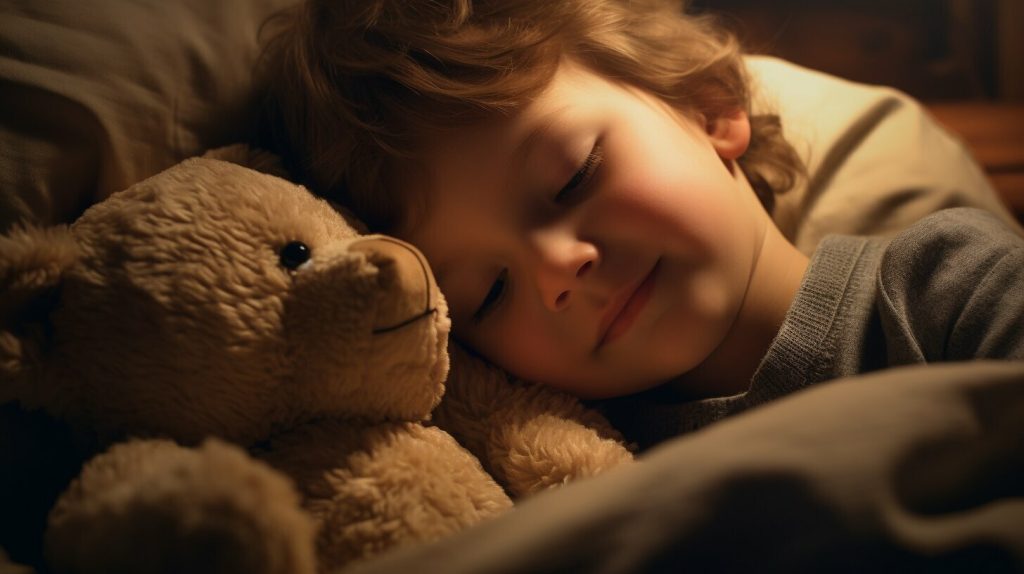
The Risks of Introducing a Blanket Too Early
Introducing a blanket to a child’s sleep routine before the recommended age can pose significant risks to their safety.
Accidental suffocation can occur if a baby’s face is covered by a blanket while asleep.
This can obstruct their airways and lead to suffocation. Similarly, the presence of a blanket in the sleep environment can increase the risk of SIDS, a sudden and unexplained death of an otherwise healthy baby.
To reduce the risk of these dangers, following the recommended guidelines and waiting until your child is at least 18 months old before introducing a blanket into their sleep space is crucial.
By this age, most children have developed the motor skills necessary to adjust their position and remove any potential obstructions from their faces.
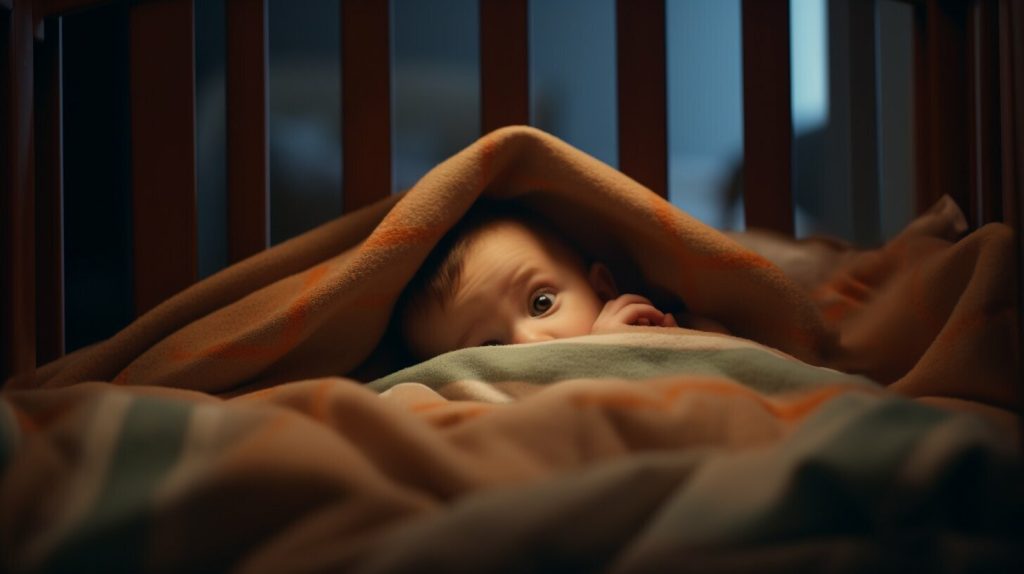
In the meantime, there are safe alternatives to blankets for younger babies. Swaddling can provide a sense of security and help infants sleep better.
However, swaddling should no longer be practised once a baby starts rolling over to prevent the risk of suffocation.
Instead, layering your baby’s clothing or using a sleep sack can provide the necessary warmth without the added risk.
| Safe Age to Introduce a Blanket | Risks of Introducing a Blanket Too Early |
|---|---|
| At least 18 months old | Increased risk of accidental suffocation and SIDS |
“Introducing a blanket to a child’s sleep routine before they are developmentally ready can have serious consequences for their safety. It is crucial for parents to follow the recommended guidelines and prioritise their child’s well-being during sleep.”
Choosing the right blanket is also essential for creating a safe sleep environment. Opt for a thin, breathable blanket made of materials such as linen, muslin, or thin cotton.
These fabrics promote airflow and reduce the risk of overheating or suffocation. Additionally, it is important to ensure that the rest of the sleep space is free from hazards such as pillows, stuffed animals, or excessive bedding.
Remember, blankets are not necessary for a baby’s comfort or security. If a comfort object like a stuffed animal is introduced, it should be small and not used for playing to reduce the risk of suffocation.
By following these guidelines and prioritising sleep safety, parents can provide their child with a secure and peaceful sleep environment.
Safe Alternatives to Blankets for Younger Babies
For younger babies, there are safe alternatives to using blankets for sleep.
To ensure a safe sleep environment, parents can consider the following alternatives:
- Swaddling: Swaddling can provide a sense of security and help babies sleep better. However, it is important to note that swaddling should be discontinued once a baby starts rolling over. This prevents any risk of suffocation when the baby can move their arms and legs freely.
- Layered Clothing: Layering your baby’s clothing is a practical and safe way to keep them warm during sleep. Opt for lightweight and breathable fabrics such as cotton to prevent overheating.
- Sleep Sacks: Sleep sacks, also known as wearable blankets, are a popular choice for parents who want to provide warmth without the risks associated with loose blankets. These sacks are designed to keep the baby snug while allowing freedom of movement.
It is important to remember that blankets are not necessary for a baby’s comfort or security. If a comfort object is introduced, such as a small stuffed animal, it should not be used for playing and should be placed away from the baby’s face during sleep.
By following these guidelines, parents can ensure their baby’s safety while providing them with a restful and comfortable sleep environment.
| Pros | Cons |
|---|---|
| Swaddling provides a sense of security. | Swaddling should be discontinued once the baby starts rolling over. |
| Layered clothing allows for easy temperature regulation. | It may be challenging to find the right balance of layers for optimal comfort. |
| Sleep sacks provide warmth without the risk of suffocation. | Some babies may not like the feeling of being confined in a sleep sack. |
Remember, waiting until a baby is at least 18 months old is recommended before introducing a blanket into their sleep space.
When the time comes, choose a thin, breathable blanket made of materials such as linen, muslin, or thin cotton. In the meantime, these safe alternatives can provide a comfortable and secure sleep environment for younger babies.
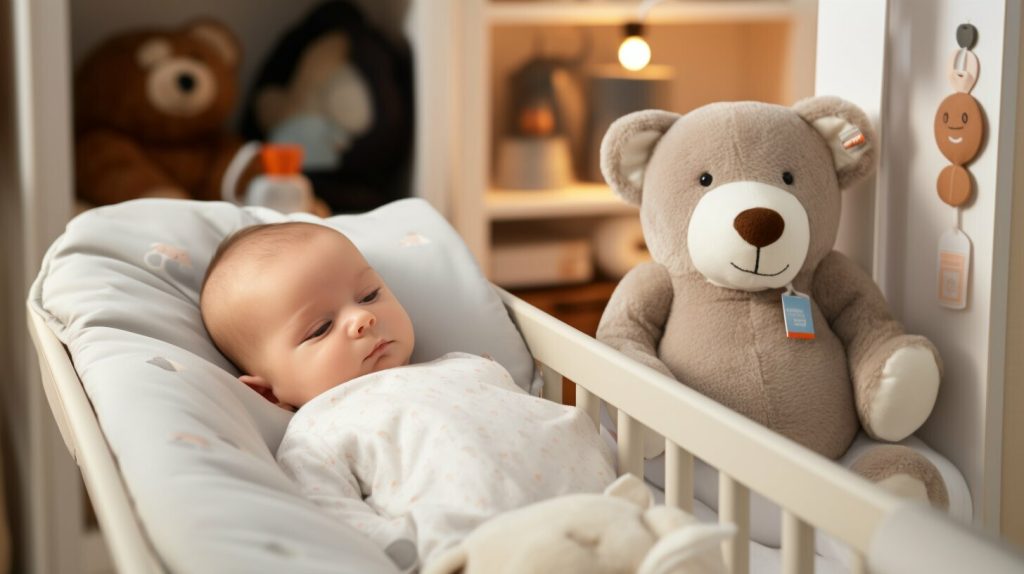
Choosing the Right Blanket for a Child’s Sleep
Selecting the right blanket for a child’s sleep is crucial for their safety and comfort. When it comes to choosing a blanket, there are a few key factors to consider.
First and foremost, opt for a thin and breathable material such as linen, muslin, or thin cotton.
These fabrics allow for better air circulation, reducing the risk of overheating and promoting a comfortable sleep environment. It’s important to ensure that the blanket is not too heavy or bulky, as this can pose a suffocation hazard.
In addition to the material, the size of the blanket is also important. It should be appropriately sized for the child’s age and developmental stage.
A too large blanket can increase the risk of entanglement or cover the child’s face, while one that is too small may not provide adequate warmth.
Choosing a blanket that allows for freedom of movement while still providing sufficient coverage is recommended.
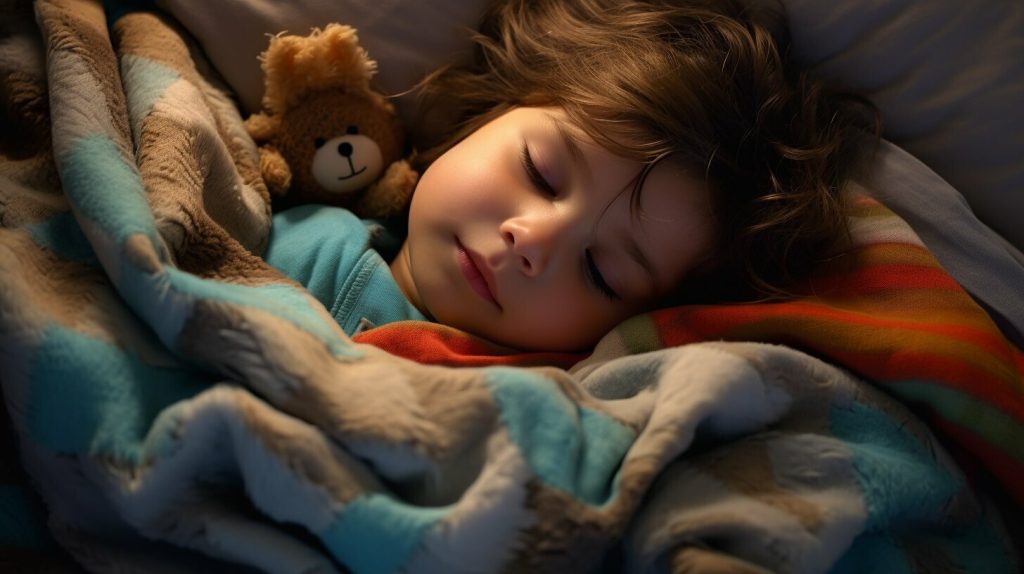
To create a safe sleep environment with a blanket, following certain guidelines is essential. Avoid placing other items in the crib, such as pillows, stuffed animals, or loose bedding, as these can also pose risks of suffocation.
It’s best to keep the sleeping area clear and free from any potential hazards. Regularly inspect the blanket for signs of wear and tear and replace it if necessary.
By carefully selecting a suitable blanket and ensuring a safe sleep environment, you can help promote a restful and secure night’s sleep for your child.
Blankets for Comfort and Security
While blankets can provide comfort, they are not essential for a baby’s overall sense of security during sleep. It is important to prioritise sleep safety and create a safe sleep environment for your little one.
When choosing a blanket for your child, opt for a thin, breathable option made of materials like linen, muslin, or thin cotton.
These materials allow for proper airflow while providing warmth. Creating a safe sleep environment is crucial, so ensure that the blanket is not too thick or heavy, which can increase the risk of overheating or suffocation.
Instead of relying solely on a blanket, there are other safe alternatives for younger babies. Swaddling can provide comfort and a sense of security, but once your baby starts rolling over, it is time to transition away from swaddling. Instead, consider layering your baby’s clothing or using a sleep sack to keep them warm during sleep.
It is important to note that comfort objects like stuffed animals should be small and should not be used for playing.
These objects can comfort your child, but they should not be placed in the crib or sleep environment until your little one is older.
While blankets can offer comfort, it is best to follow the recommended guidelines for sleep safety. Focus on creating a safe sleep space and consider alternatives to blankets for younger babies.
As your child grows, you can introduce a thin, breathable blanket made of suitable materials. Prioritise their safety and ensure a restful sleep for your little one.
Table: Safe Alternatives to Blankets for Younger Babies
| Sleep Aid | Description |
|---|---|
| Swaddling | Wrapping your baby snugly in a lightweight blanket or swaddle to mimic the feeling of being in the womb. |
| Sleep Sacks | These wearable blankets provide warmth and security while allowing your baby freedom of movement. |
| Layered Clothing | Dressing your baby in appropriate layers to provide warmth without the need for a blanket. |
Quote:
“While blankets can provide comfort, they are not essential for a baby’s overall sense of security during sleep.”

Blankets are not necessary for a baby’s comfort or security
Although blankets can provide comfort, it is important to remember that they are not essential for a baby’s well-being.
If a comfort object, such as a stuffed animal, is introduced, it should be small and should not be used for playing to minimise the risk of suffocation.
Creating a safe sleep environment without relying solely on a blanket for comfort is crucial in ensuring your child’s safety and well-being.
By following these guidelines, parents can take the necessary steps to provide a safe sleep environment for their children.
Remember, each child is unique, and it is essential to consult with healthcare professionals and consider your child’s individual needs when making decisions regarding their sleep routine.

| Age | Guidelines |
|---|---|
| Under 12 months | It is not safe for babies to sleep with blankets. Introducing a blanket too early can increase the risk of suffocation and SIDS. |
| 12-18 months | Consider using alternative sleep aids such as swaddling or sleep sacks for added warmth and comfort. |
| 18+ months | Choose a thin, breathable blanket made of materials like linen, muslin, or thin cotton. Ensure it is securely tucked in and does not pose any entanglement hazards. |
When Can A Child Sleep With A Blanket Final Thoughts
When it comes to allowing a child to sleep with a blanket, it is crucial to prioritise their safety by following the recommended guidelines.
According to the American Academy of Pediatrics, babies under 12 months old should not sleep with blankets due to the increased risk of accidental suffocation and Sudden Infant Death Syndrome (SIDS).
Instead, parents can opt for safer alternatives such as swaddling or using sleep sacks until their baby can safely use a blanket.
Swaddling can provide warmth and a sense of security for younger babies, but once they start rolling over, it is important to stop swaddling to avoid potential hazards.
Layering your baby’s clothing or using a sleep sack can help maintain a comfortable sleep environment without the need for a blanket.
It is generally recommended to wait until a baby reaches 18 months old before introducing a blanket into their sleep routine.
When choosing a blanket, selecting a thin, breathable option made from materials like linen, muslin, or thin cotton is essential.
These materials allow for better air circulation and reduce the risk of overheating. Additionally, it is important to create a safe sleep environment by removing any unnecessary objects or loose bedding from the crib or bed.
While blankets may provide comfort and security for older children, they are not essential for babies.
If a comfort object, such as a stuffed animal, is introduced, it should be small in size and not used for playing to ensure the child’s safety.
Remember, following the recommended guidelines for safe blanket use can help promote a safe and peaceful sleep environment for your child.
FAQs
Q: When is it safe for a child to sleep with a blanket?
A: According to the American Academy of Pediatrics, it is unsafe for babies under 12 months old to sleep with blankets. It is recommended to wait until a child is at least 18 months old before introducing a blanket into their sleep space.
Q: Why is it not safe for babies to sleep with blankets?
A: Introducing a blanket too early can increase the risk of accidental suffocation and Sudden Infant Death Syndrome (SIDS).
Q: What are the safe alternatives to blankets for younger babies?
A: Swaddling can be a safer alternative to blankets, but once a baby starts rolling over, parents should no longer swaddle. Instead, layer your baby’s clothing or use a sleep sack for warmth.
Q: What should I consider when choosing a blanket for my child’s sleep?
A: It is recommended to choose a thin, breathable blanket made of linen, muslin, or thin cotton. Creating a safe sleep environment is crucial, so ensure the blanket is the right size and does not pose any suffocation hazards.
Q: Are blankets necessary for a baby’s comfort or security?
A: Blankets are not necessary for a baby’s comfort or security. If a comfort object like a stuffed animal is introduced, it should be small and not used for playing.


